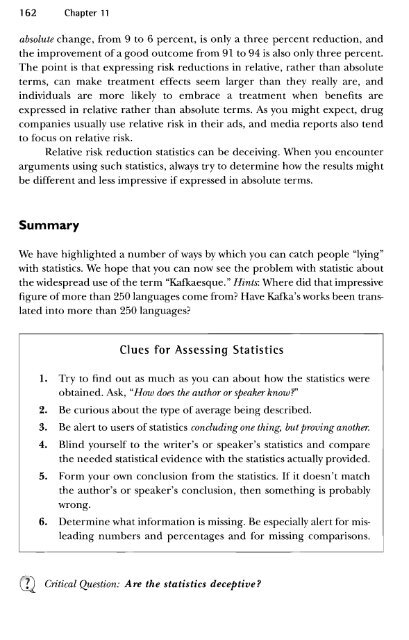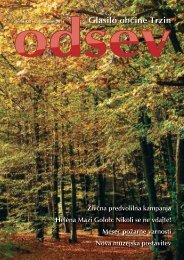Asking the Right Questions, A Guide to Critical Thinking, 8th Ed
Asking the Right Questions, A Guide to Critical Thinking, 8th Ed
Asking the Right Questions, A Guide to Critical Thinking, 8th Ed
You also want an ePaper? Increase the reach of your titles
YUMPU automatically turns print PDFs into web optimized ePapers that Google loves.
162 Chapter 11<br />
absolute change, from 9 <strong>to</strong> 6 percent, is only a three percent reduction, and<br />
<strong>the</strong> improvement of a good outcome from 91 <strong>to</strong> 94 is also only three percent.<br />
The point is that expressing risk reductions in relative, ra<strong>the</strong>r than absolute<br />
terms, can make treatment effects seem larger than <strong>the</strong>y really are, and<br />
individuals are more likely <strong>to</strong> embrace a treatment when benefits are<br />
expressed in relative ra<strong>the</strong>r than absolute terms. As you might expect, drug<br />
companies usually use relative risk in <strong>the</strong>ir ads, and media reports also tend<br />
<strong>to</strong> focus on relative risk.<br />
Relative risk reduction statistics can be deceiving. When you encounter<br />
arguments using such statistics, always try <strong>to</strong> determine how <strong>the</strong> results might<br />
be different and less impressive if expressed in absolute terms.<br />
Summary<br />
We have highlighted a number of ways by which you can catch people "lying"<br />
with statistics. We hope that you can now see <strong>the</strong> problem with statistic about<br />
<strong>the</strong> widespread use of <strong>the</strong> term "Kafkaesque." Hints: Where did that impressive<br />
figure of more than 250 languages come from? Have Kafka's works been translated<br />
in<strong>to</strong> more than 250 languages?<br />
Clues for Assessing Statistics<br />
1. Try <strong>to</strong> find out as much as you can about how <strong>the</strong> statistics were<br />
obtained. Ask, "How does <strong>the</strong> author or speaker know?"<br />
2. Be curious about <strong>the</strong> type of average being described.<br />
3. Be alert <strong>to</strong> users of statistics concluding one thing, but proving ano<strong>the</strong>r.<br />
4. Blind yourself <strong>to</strong> <strong>the</strong> writer's or speaker's statistics and compare<br />
<strong>the</strong> needed statistical evidence with <strong>the</strong> statistics actually provided.<br />
5. Form your own conclusion from <strong>the</strong> statistics. If it doesn't match<br />
<strong>the</strong> author's or speaker's conclusion, <strong>the</strong>n something is probably<br />
wrong.<br />
6. Determine what information is missing. Be especially alert for misleading<br />
numbers and percentages and for missing comparisons.<br />
J) <strong>Critical</strong> Question: Are <strong>the</strong> statistics deceptive?



